Looking for a healthier, homemade dog food option? You’ve come to the right place! Our guide shows you how to make your own Farmer’s Dog food at home. It’s easy and cost-effective. Using human-grade ingredients, these DIY pet food recipes offer tasty, nutritious meals for your dog. They also help save money and ensure your pet’s health. Start making homemade dog food today and give your pet the top-notch diet they deserve!
Benefits of Homemade Dog Food
Making dog food at home offers great benefits for you and your pet. You can make sure they get a balanced diet. Plus, you’ll save money and know exactly what’s in their food.
Health Advantages
Homemade dog food is healthier. You avoid bad preservatives and fillers that store-bought food has. Dogs often get better skin and fewer allergies.
They also enjoy better digestion, more energy, and a stronger immune system with fresh food.
Cost-Effectiveness
Making dog food at home can save you money. Store-bought premium foods are costly. With homemade food, you can use inexpensive bulk ingredients and even leftovers.
This way, you save money and still feed your pet well. It’s a smart choice if you’re watching your budget.
Ingredient Control
Controlling what goes into your dog’s food is a major benefit. You can make meals that fit your dog’s health needs. This is perfect for dogs with allergies or other special dietary requirements.
This custom approach helps keep your dog healthy. You can ensure they get the best nutrition for their needs.
Essential Ingredients for the Copycat Farmer’s Dog Food Recipe
When recreating Farmer’s Dog-style meals at home, the secret lies in using fresh, whole ingredients that provide balanced nutrition while keeping your dog’s meals simple and wholesome. These aren’t just tasty — they help support energy, digestion, skin health, and longevity.
Here are the core building blocks every copycat Farmer’s Dog recipe should include:
1. High-Quality Protein
Protein is the foundation of every healthy dog meal. It fuels muscle repair, supports growth, and keeps your pet strong and active.
Best options: Lean ground beef, chicken breast, ground turkey, salmon, or lamb.
Tip: Choose fresh, human-grade meat whenever possible — avoid heavily processed or fatty cuts.
2. Complex Carbohydrates
Carbs give your dog steady energy and help with digestion when chosen wisely.
Best options: Sweet potatoes, brown rice, quinoa, or oatmeal.
Why it matters: These ingredients are rich in fiber, vitamins, and minerals, making them ideal for dogs with sensitive stomachs.
3. Fresh Vegetables
Veggies add vital nutrients and antioxidants that boost your dog’s immune system and promote healthy skin and coat.
Best options: Carrots, spinach, broccoli, peas, zucchini, or pumpkin.
Tip: Lightly steam or cook veggies to make them easier to digest and preserve nutrients.
4. Healthy Fats
Healthy fats provide energy, improve coat shine, and support brain and joint function.
Best options: Olive oil, coconut oil, or fish oil (rich in omega-3 fatty acids).
Tip: Add oils after cooking to preserve their nutritional value.
5. Functional Add-Ins
These extras can make a big difference in your dog’s health and well-being.
Optional boosters: Ground flaxseed (fiber and omega-3s), turmeric (anti-inflammatory), eggs (protein and biotin), and plain yogurt (probiotics).
Why it matters: Functional ingredients help fine-tune your dog’s diet and address specific needs like digestion, inflammation, or joint care.
Adjusting Recipes for Dogs with Allergies
It’s vital to tackle dog food allergies for your pet’s diet. Knowing key allergens helps craft a healthy diet that avoids these triggers. This ensures your dog stays healthy and happy.
Common Dog Allergens
Beef, dairy, and wheat often cause allergies in dogs. These can lead to itching and stomach issues. Knowing what upsets your dog’s stomach is crucial for their health.
Substitution Options
You can swap out allergens with safer ingredients. For example, salmon can replace beef, offering a rich protein source without the allergic risk. Grains like quinoa or oats are great alternatives to wheat, they’re nutritious and less likely to cause issues.
Consulting Your Vet
Talk to your vet before changing your dog’s diet, especially for allergies. They’ll design a meal plan that’s both nutritious and safe for your dog. Getting vet advice means you’re making the best choices for your pet’s health.
Maintaining a Balanced Diet for Your Dog
It’s essential for your dog’s health to eat a balanced diet. A perfect mix includes proteins, vegetables, and grains. Usually, aim for 50% protein, 25% veggies, and 25% grains. This helps with muscle growth, digestion, and keeping energy high.
Protein to Vegetables Ratio
The mix of protein and vegetables in your dog’s diet is key. Lean meats like chicken and fish should be half of their food. Veggies such as carrots and peas should be a quarter. This ensures your dog gets the right nutrients for strong muscles and a healthy body.
Optimal Feeding Schedule
Having a regular feeding schedule is good for your dog. Feeding them in the morning and evening helps with their metabolism. Depending on their age, size, and how active they are, you might adjust how much they eat. This keeps them healthy.
Supplementary Ingredients
Adding supplements to homemade dog food can be important. Ingredients like calcium and omega-3 fatty acids fill nutritional gaps. Always check with your vet before adding supplements. This makes sure your dog’s homemade meals are fully nutritious.
🥩 1. Beef & Sweet Potato Feast (Copycat Farmer’s Dog Beef Recipe)
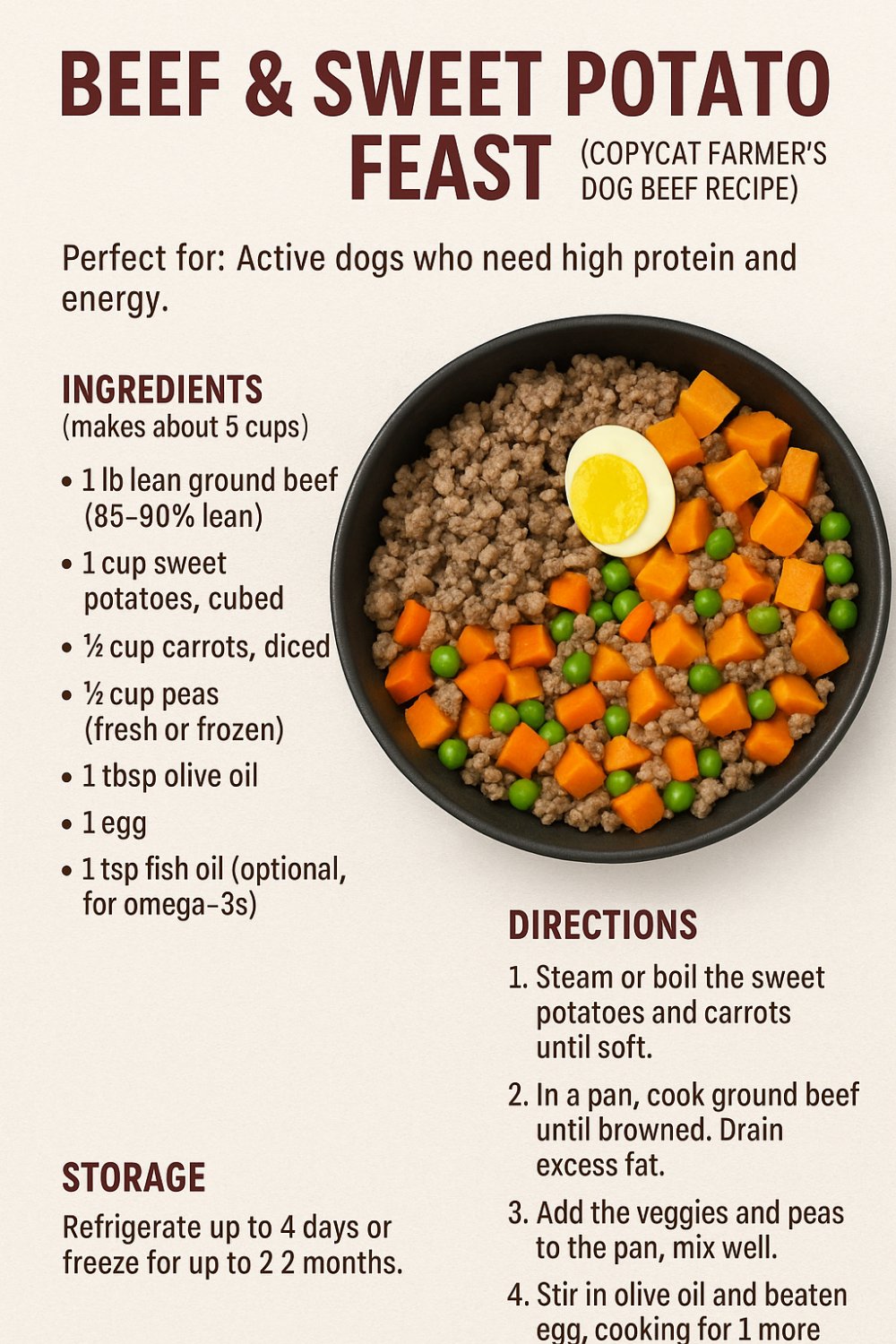
Perfect for: Active dogs who need high protein and energy.
Ingredients (makes about 5 cups):
-
1 lb lean ground beef (85–90% lean)
-
1 cup sweet potatoes, cubed
-
½ cup carrots, diced
-
½ cup peas (fresh or frozen)
-
1 tbsp olive oil
-
1 egg
-
1 tsp fish oil (optional, for omega-3s)
Directions:
-
Steam or boil the sweet potatoes and carrots until soft.
-
In a pan, cook ground beef until browned. Drain excess fat.
-
Add the veggies and peas to the pan, mix well.
-
Stir in olive oil and beaten egg, cooking for 1 more minute until the egg sets.
-
Let it cool before serving.
Storage: Refrigerate up to 4 days or freeze for up to 2 months.
Nutritional Tip: Add a canine multivitamin or calcium supplement to ensure complete nutrition.
🐔 2. Chicken & Quinoa Comfort Bowl

Perfect for: Dogs with sensitive stomachs.
Ingredients (makes about 5 cups):
-
1 lb ground chicken or finely chopped chicken breast
-
½ cup quinoa (uncooked)
-
1 cup spinach, chopped
-
½ cup carrots, shredded
-
½ cup zucchini, diced
-
1 tbsp coconut oil
-
½ tsp turmeric powder (optional anti-inflammatory boost)
Directions:
-
Cook quinoa according to package instructions.
-
In a skillet, heat coconut oil and cook chicken until no longer pink.
-
Add carrots, zucchini, and spinach; sauté for 5 minutes.
-
Mix in cooked quinoa and turmeric; stir well.
-
Cool before serving.
Storage: Keep in fridge for up to 4 days or freeze in meal portions.
Nutritional Tip: You can mix in a small amount of plain yogurt for probiotics before serving.
🐟 3. Turkey & Veggie Power Mix
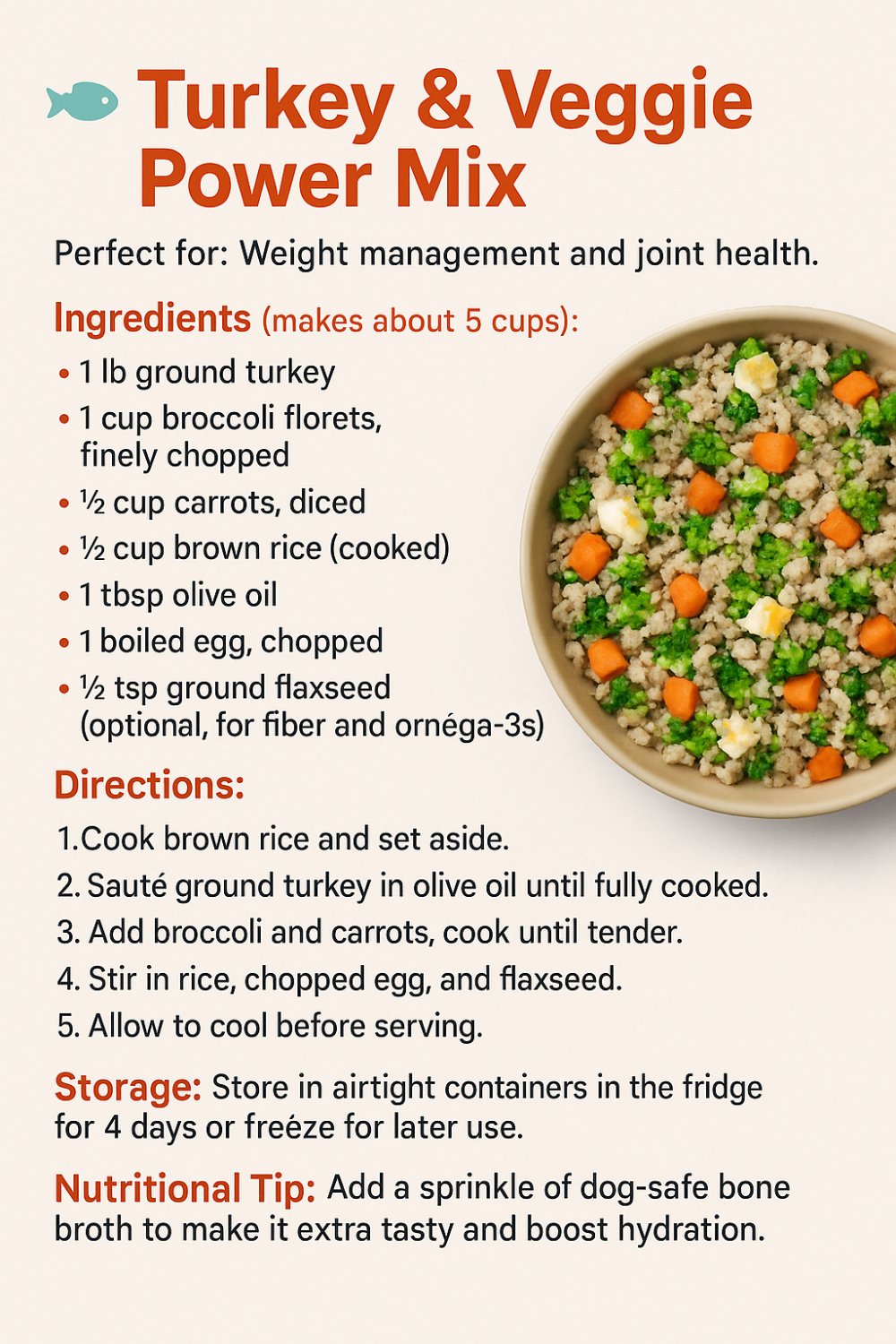
Perfect for: Weight management and joint health.
Ingredients (makes about 5 cups):
-
1 lb ground turkey
-
1 cup broccoli florets, finely chopped
-
½ cup carrots, diced
-
½ cup brown rice (cooked)
-
1 tbsp olive oil
-
1 boiled egg, chopped
-
½ tsp ground flaxseed (optional, for fiber and omega-3s)
Directions:
-
Cook brown rice and set aside.
-
Sauté ground turkey in olive oil until fully cooked.
-
Add broccoli and carrots, cook until tender.
-
Stir in rice, chopped egg, and flaxseed.
-
Allow to cool before serving.
Storage: Store in airtight containers in the fridge for 4 days or freeze for later use.
Nutritional Tip: Add a sprinkle of dog-safe bone broth to make it extra tasty and boost hydration.
Conclusion
As our journey into homemade dog food wraps up, we see many benefits. Making your own version of Copycat Farmer’s Dog food recipe means fresh, balanced meals for your pet. It’s cheaper than store-bought food, too. Plus, you can pick what goes in their meals, focusing on their health needs.
Making your dog’s food lets you choose top-notch ingredients. You can also make meals that your dog will love and that are good for them. This look at homemade dog food shows it can make your pet healthier and happier. Starting to make your dog’s food can be rewarding and bring you two closer.
Diving into homemade dog food can be fulfilling. Many pet owners’ success stories prove its value. With tips from this article, you’re ready to begin. This recap confirms that your effort can make your pet’s life better. You can give them a healthier, more joyful life.


























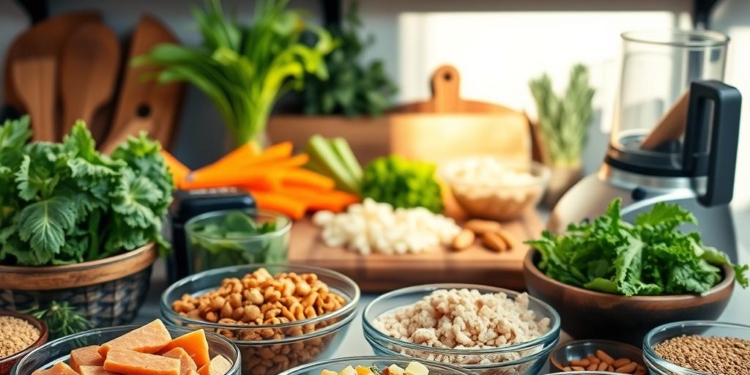

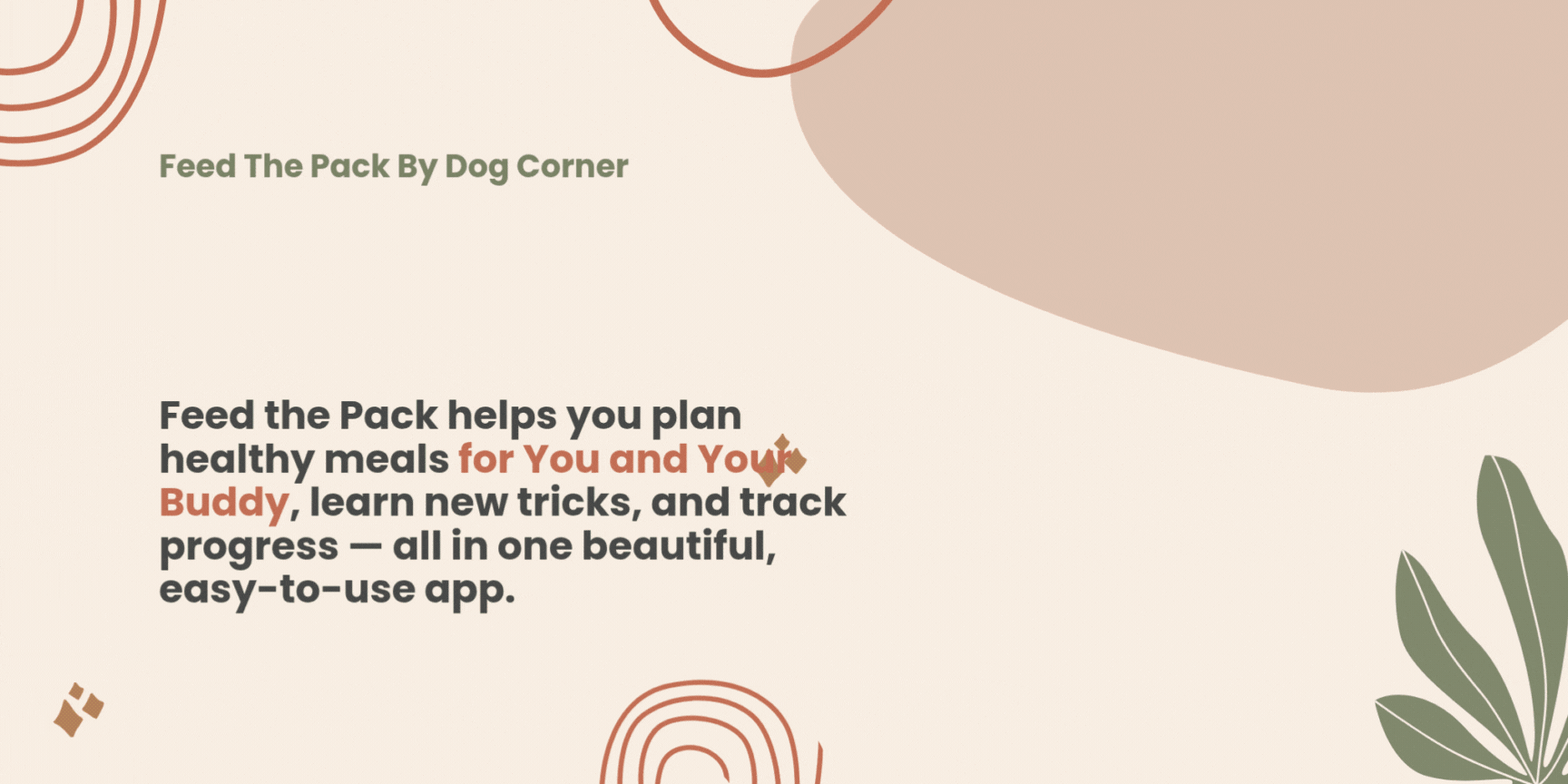





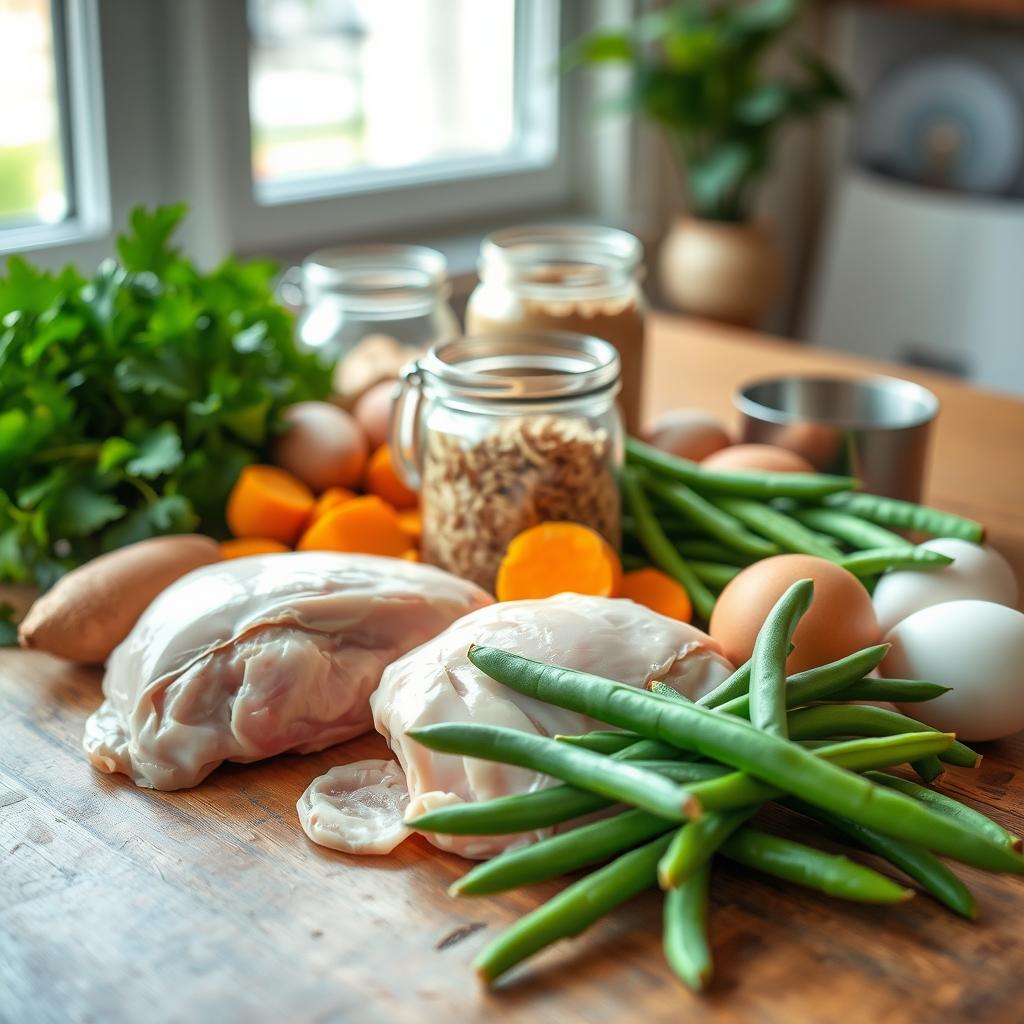
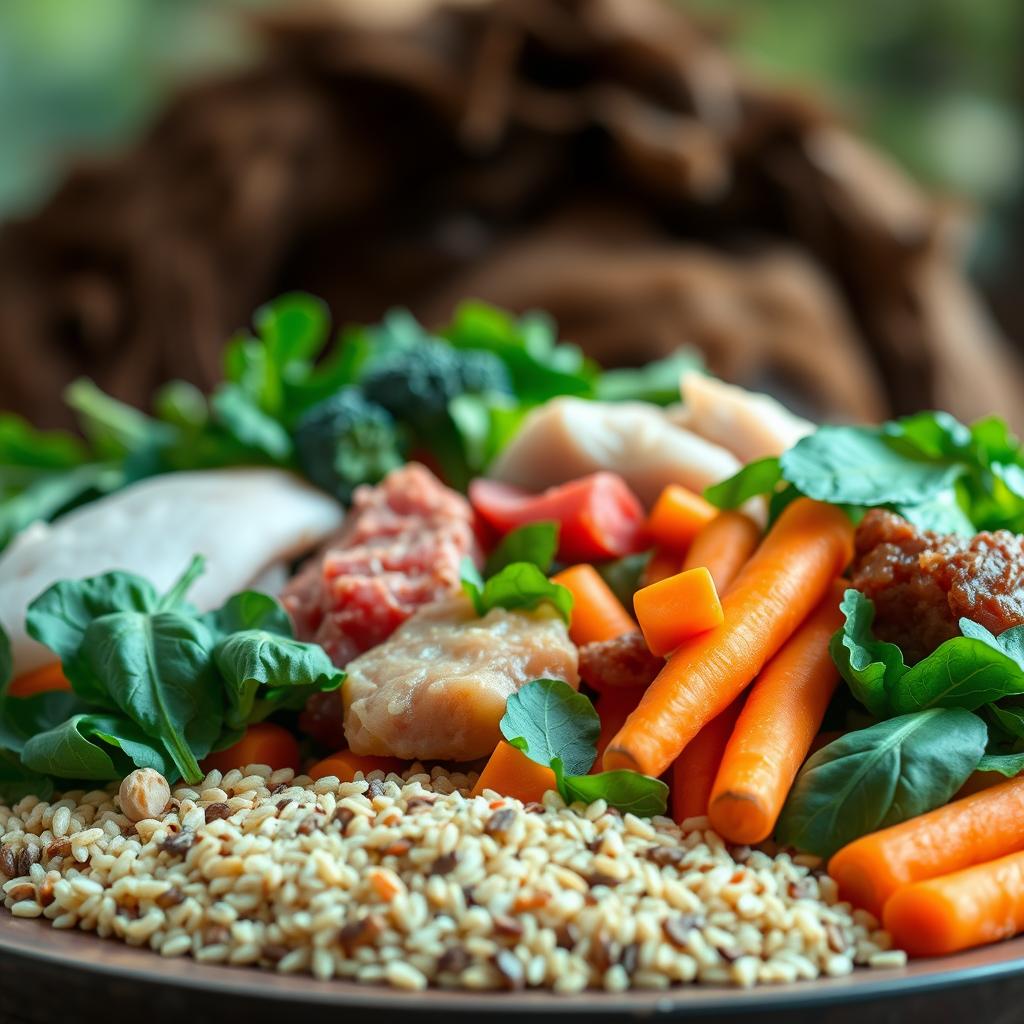















Discussion about this post